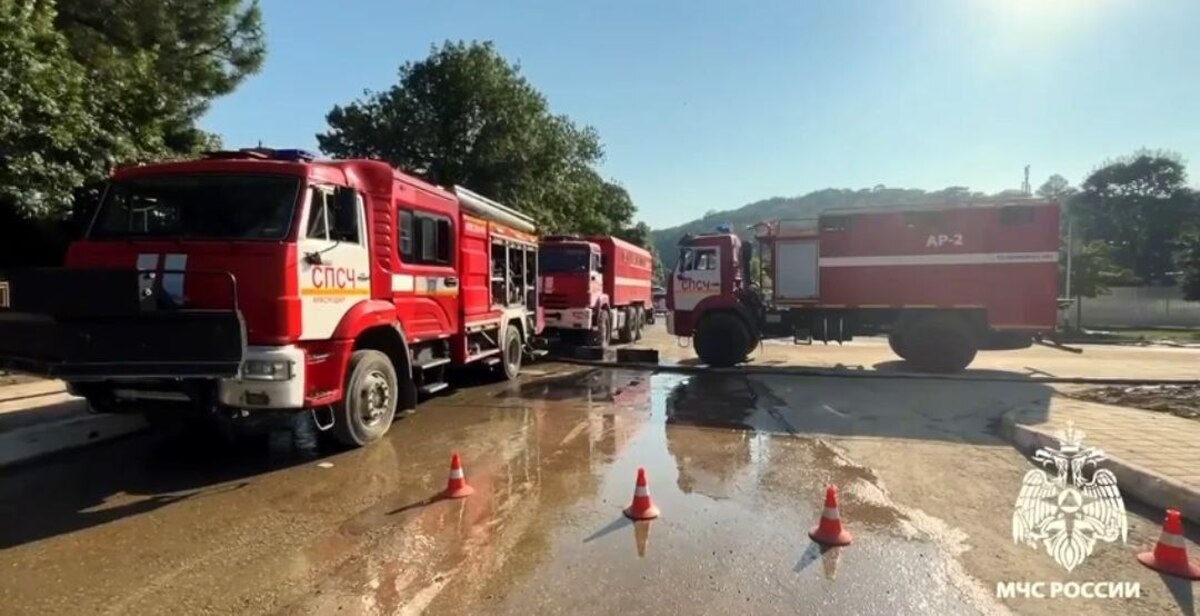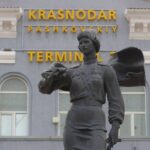In the Tuapse district, efforts to eliminate the consequences of the natural disaster that struck the municipality on August 3 continue. Currently, over 180 specialists and 51 units of Russian Emergency Ministry equipment are working in the area.
In the village of Lermontovo, the weather-damaged water pipeline has been partially restored. Nineteen tanks with technical water have been installed. In the settlement of Novomikhailovsky, a drinking water distribution point was set up at School No. 35.
Assessment commissions have surveyed 381 addresses, according to the press service of the Russian Emergency Ministry’s regional branch for Krasnodar Krai.
In the Tuapse district, water levels rose in populated areas of the Dzhubga, Tenginsky, and Novomikhailovsky settlements. In the village of Lermontovo, the river overflowed. The head of the Tuapse district noted that 300 houses remained cut off without a crossing.
Later, the governor of Krasnodar Krai clarified that the bridge over the Shapsukho River in Lermontovo would undergo repairs, with work set to begin in mid-August. Regarding water supply in Lermontovo, the governor stated that part of the village had already been reconnected by August 5, with the rest expected by the evening of August 7. Until then, water would be delivered as needed.
In the settlement of Novomikhailovsky, the governor instructed that School No. 30 and Kindergarten No. 10 be restored by September, along with finding ways to protect the school from future natural disasters.
Tuapse district
The Tuapse District is a coastal region in Krasnodar Krai, Russia, known for its scenic Black Sea coastline, subtropical climate, and mountainous landscapes. Historically, it was inhabited by ancient tribes and later became part of the Russian Empire in the 19th century, playing a strategic role in trade and defense. Today, it is a popular tourist destination, offering beaches, resorts, and cultural sites reflecting its diverse heritage.
Lermontovo
Lermontovo is a small urban settlement in Russia’s Kaluga Oblast, named after the famous Russian poet Mikhail Lermontov. While it does not have direct historical ties to the poet, the name honors his literary legacy. The area is primarily known for its rural surroundings and peaceful atmosphere, rather than significant historical or cultural landmarks.
Novomikhailovsky
Novomikhailovsky is a coastal settlement in Russia’s Krasnodar Krai, located along the Black Sea. Originally established in the 19th century as a Cossack outpost, it later developed into a popular seaside resort known for its beaches and subtropical climate. Today, it attracts tourists with its scenic landscapes, proximity to the Caucasus Mountains, and relaxed atmosphere.
School No. 35
School No. 35, also known as the “Memorial School for the Victims of the Gulag,” is located in Perm, Russia. It was established in the Soviet era and later became a memorial dedicated to the victims of Stalinist repression, particularly those who suffered in the nearby Perm-36 labor camp. Today, it serves as an educational and historical site, preserving the memory of political persecution under the Soviet regime.
Dzhubga
Dzhubga is a coastal village in Russia’s Krasnodar Krai, located on the Black Sea. Known for its pebble beaches and scenic landscapes, it has become a popular summer destination for tourists. Historically, the area was inhabited by the Shapsug people, a subgroup of the Adyghe, before becoming part of Russia in the 19th century.
Tenginsky
Tenginsky (or Tenginsky) refers to the Tenginskoye settlement, an archaeological site in Russia’s Krasnodar Krai, associated with the ancient Meotian culture (6th–3rd centuries BCE). It was a fortified settlement of the Meotians, an indigenous people of the Kuban region, and later influenced by Greek and Sarmatian contacts. The site provides insights into the trade and daily life of pre-Slavic tribes in the North Caucasus.
(Note: If “Tenginsky” refers to a different location, please provide additional context for accuracy.)
Shapsukho River
The Shapsukho River is a small river located in the Krasnodar Krai region of Russia, flowing through the western Caucasus Mountains near the Black Sea coast. It is known for its scenic beauty and is situated near the historical lands of the Shapsugs, a subgroup of the Circassian (Adyghe) people, who have inhabited the area for centuries. The river and its surroundings are part of the rich cultural heritage of the indigenous Circassian communities, though much of their history was disrupted by 19th-century Russian expansion and forced migrations.
School No. 30
School No. 30, also known as the “Railway Workers’ School,” is a historic educational institution in Lviv, Ukraine, originally established in the early 20th century. It gained recognition for its strong academic traditions and architectural significance, reflecting Austro-Hungarian influences. During World War II, the school continued to operate, serving as a symbol of resilience in the face of adversity.






